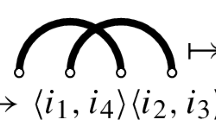Abstract
We investigate the charges and fluxes that can occur in higher-order Abelian gauge theories defined on compact space-time manifolds with boundary. The boundary is necessary to supply a destination to the electric lines of force emanating from brane sources, thus allowing non-zero net electric charges, but it also introduces new types of electric and magnetic flux. The resulting structure of currents, charges, and fluxes is studied and expressed in the language of relative homology and de Rham cohomology and the corresponding abelian groups. These can be organised in terms of a pair of exact sequences related by the Poincaré-Lefschetz isomorphism and by a weaker flip symmetry exchanging the ends of the sequences. It is shown how all this structure is brought into play by the imposition of the appropriately generalised Maxwell’s equations. The requirement that these equations be integrable restricts the world-volume of a permitted brane (assumed closed) to be homologous to a cycle on the boundary of space-time. All electric charges and magnetic fluxes are quantised and satisfy the Dirac quantisation condition. But through some boundary cycles there may be unquantised electric fluxes associated with quantised magnetic fluxes and so dyonic in nature.
Similar content being viewed by others
References
Alvarez O. (1985) Topological quantisation and cohomology. Commun. Math. Phys. 100, 279–309
Alvarez M., Olive D.I. (2000) The Dirac quantisation condition for fluxes on four-manifolds.Commun. Math. Phys. 210, 13–28
Alvarez M., Olive D.I. (2001) Spin and abelian electromagnetic duality on four-manifolds. Commun. Math. Phys. 217, 331–356
Bott R., Tu L.W., (1982) Differential forms in algebraic topology Graduate Texts in Mathematics 82. Berlin Heidelberg New York, Springer
Cremmer E., Julia B., Scherk J. (1978) Supergravity Theory In 11 Dimensions. Phys. Lett. 76, 409
Cremmer E., Scherk J. (1974) Spontaneous dynamical breaking of gauge symmetry in dual models. Nucl. Phys. 72, 117–124
Dirac P.A.M. (1931) Quantised singularities in the electromagnetic field. Proc. Roy. Soc. A133, 60–72
de Rham, G.: Variétés Différentiables. Paris: Hermann 1955; Differentiable Manifolds. Comprehensive Studies in Mathematics 266, Berlin Heidelberg New York: Springer, 1984
Deser S., Gomberoff A., Henneaux M., Teitelboim C. (1997) Duality, self-duality, source and charge quantisation in abelian N-form theories. Phys. Lett. B 400, 80–86
Diemer T., Hadley M.J. (1999) Charge and the topology of space-time. Class. Quant. Grav. 16, 3567–3577
Flanders, H.: Differential forms, with applications to the physical sciences. New York: Academic, 1963, New York: Dover, 1989
Figueroa-O’Farrill J., Stanciu S. (2001) D-brane charge, flux quantisation and relative (co)homology”. JHEP 0101: 006
Hodge W.V.D., (1952) The theory and applications of harmonic integrals. Cambridge, Cambridge University Press
Henneaux M., Teitelboim C. (1986) p-form Electrodynamics. Found. Phys. 16, 593–717
Kalb M., Ramond P. (1974) Classical Direct Interstring Action. Phys. Rev. D9, 2273–2284
Kalkkinen J., Stelle K. (2003) Large gauge transformations in M-theory. J. Geom. Phys. 48, 100–132
M. Massey, W.S.: A basic course in algebraic topology. Graduate Texts in Mathematics 127, Berlin Heidelberg New York: Springer, 1991
Misner C.W., Wheeler J.A. (1957) Classical Physics as Geometry. Annals of Phys. 2, 525–603
Moore G., Witten E. (2000) Self-duality, Ramond-Ramond fields, and K-theory. JHEP 0005, 32
Montonen C., Olive D.I. (1977) Magnetic monopoles as gauge particles? Phys. Lett. B72, 117–120
Nepomechie R. (1985) Magnetic monopoles from antisymmetric tensor gauge fields. Phys. Rev. D31, 1921-1924
Orland P. (1982) Instantons and Disorder in Antisymmetric Tensor gauge fields. Nucl. Phys. B205[FS8]: 107–118
Schwarz A. Topology for Physicists. Comprehensive Studies in Mathematics 308, Berlin Heidelberg New York: Springer, 1994
Schwinger J.S. (1969) A Magnetic Model Of Matter. Science 165, 757
Sen A. (1994) Dyon-monopole bound states, self-dual harmonic forms on the multimonopole moduli space, and SL(2, \(\mathbb{Z})\) invariance in string theory. Phys. Lett. 329, 217-221
Sorkin R. (1977) On the relation between charge and topology. J. Phys. A10, 717–725
Sorkin R. (1979) The quantum electromagnetic field in multiply connected space. J. Phys. A12, 403–421
Strominger A. (1996) Open p-branes. Phys. Lett. B 383, 44–47
Teitelboim C. (1986) Gauge invariance for extended objects. Phys. Lett. B 167, 63–68
Teitelboim C. (1986) Monopoles of higher rank. Phys. Lett. B 167, 69–72
Verlinde E. (1995) Global aspects of electric-magnetic duality. Phys. Lett. B 455, 211–228
Witten E. (1979) Dyons Of Charge eθ / 2 π. Phys. Lett. B86, 283–287
Witten E. (1995) On S-duality in abelian gauge theory. Selecta Math (NS) 1, 383–410
Witten E. (1997) On flux quantization in M-theory and the effective action. J. Geom. Phys. 22, 1–13
Witten E. (2001) Overview of K-theory applied to strings. Int. J. Mod. Phys. A 16, 693
Wu T.T., Yang C.N. (1975) Concept of non-integrable phase factors and global formulation of gauge fields. Phys. Rev. D12, 3845–3857
Zucchini R. (2003) Abelian duality and Wilson loops. Commun. Math. Phys. 242, 473–500
Zwanziger D. (1968) Quantum Field Theory Of Particles With Both Electric And Magnetic Charges. Phys. Rev. 176: 1489
Author information
Authors and Affiliations
Corresponding author
Additional information
Communicated by G.W. Gibbons
Rights and permissions
About this article
Cite this article
Alvarez, M., Olive, D.I. Charges and Fluxes in Maxwell Theory on Compact Manifolds with Boundary. Commun. Math. Phys. 267, 279–305 (2006). https://doi.org/10.1007/s00220-006-0065-6
Received:
Accepted:
Published:
Issue Date:
DOI: https://doi.org/10.1007/s00220-006-0065-6



